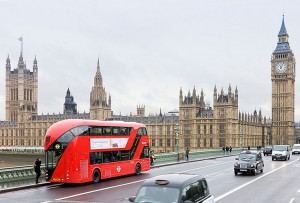
On the 16 December a new, next generation double decker bus, was presented in London. Transport for London that commissioned the buses, claims the hybrid double-decker bus “will be the most environmentally friendly bus of its kind when it enters passenger service.” The engineering test vehicle uses a hybrid drivetrain developed by Volvo and emits only 640 grams of CO2 per kilometer. This is less than half of that of current diesel buses emits. During testing fuel economy was also better than twice that of a standard diesel bus, clocking in at 11.6 mpg.
Transport for London awarded the contract for engineering design early 2010 to Wrightbus, a company based in Northern Ireland. Wrightbus in collaboration with London’s Heatherwick Studio have now have finished the first prototype, and is ready to show it off. London Mayor Boris Johnson proudly proclaimed at the unveil that “It is the latest, greatest masterpiece of British engineering and design, and I am certain it will become a much-loved and iconic vehicle akin to the legendary Routemaster from which it draws so much inspiration”. The first bus is planned to begin carrying passengers on the busy Route 38 (Victoria station to Hackney) on February 20, 2012.
To begin with a total of eight prototype buses will enter passenger service in the first half of 2012, and if the trial is successful, hundreds of them could be running around London in the coming years. The new bus has a modern sleek design, with tree entrances and two staircases to making it easy to get on and of the bus. It is also equipped with large windows that curve and follow alongside the stairs to increase the amount of light let in. As the well known Routemaster buses, there is also an open platform at the rear.
The bus is intended for city use where its battery will be charged while the bus is waiting in traffic, or at the traffic lights. Long outstation drives or drives along the highway could result in the battery being depleted, something that rather embarrassingly happened just three days after the prototype had been introduced. The bus was spotted by commuters at the side of the M1 near Dunstable, chugging to a standstill at the side of a motorway after its battery ran out.
Mike Weston, London Buses Operations Director, said “The bus is designed for stop-start driving, which enables the battery to be recharged automatically. However when the bus undertakes long, non-stopping motorway journeys, such as its journey to Bedfordshire this morning, it can lose charge and the driver is briefed to pull to the side of the road to allow the battery to recharge.” To add insult to injury after the battery had re-charged the driver was unable to re-start the engine. It was later established that the bus had run out of diesel. “Once the bus was refuelled it carried on its journey. We will be speaking with the operator to ensure that this does not happen again”, said Mike Weston
